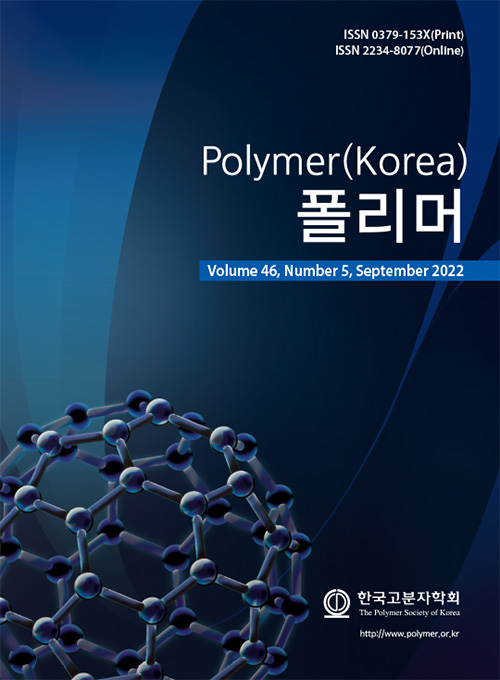- Effect of Radical Initiators on the Phase Structure and Rheological Properties of PLA/PBAT/Multi-walled Carbon Nanotube Composites
Department of Chemical Engineering, Dankook University, 152 Jukjeon-ro, Yongin-si, Gyeonggi 16890, Korea
- 라디칼 개시제가 PLA/PBAT/Multi-walled Carbon Nanotube 복합체의 상구조와 유변물성에 미치는 영향
단국대학교 화학공학과
Reproduction, stored in a retrieval system, or transmitted in any form of any part of this publication is permitted only by written permission from the Polymer Society of Korea.
Blends of polylactic acid (PLA)/poly(butylene adipate-co-terephthalate) (PBAT) (80/20) blend and their composites with multiwalled carbon nanotube (MWNT) were prepared using a batch mixer. In the melt-mixing process, benzoyl peroxide (BPO), azobisisobutyronitrile (AIBN), and dicumyl peroxide (DCP) were introduced as radical initiators to achieve reactive compatibilization by coupling reactions of the components. The phase structure and rheological properties of the blends and composites were investigated. It was found that the size of the PBAT dispersed phase was reduced, and the melt viscosity increased in the PLA/PBAT/initiator blend by the intended reactions of the initiators. The dispersion state of PBAT and the distribution of MWNTs between PLA and PBAT were sensitively changed by the interactions between the component polymers and MWNTs, which depended on the characteristics of the initiators and mixing protocols. Changes in the microstructure of the composites were explained in relation to the modified Cole-Cole plots.
배치믹서를 이용하여 polylactic acid(PLA)/poly(butylene adipate-co-terephthalate)(PBAT)(80/20) 블렌드와 multiwalled carbon nanotube(MWNT)와의 복합체를 제조하였다. 용융 혼련의 과정에서 라디칼 결합반응에 의한 반응성 상용화를 달성하기 위하여 라디칼 개시제로서 benzoyl peroxide(BPO), azobisisobutyronitrile(AIBN), 그리고 dicumyl peroxide(DCP)를 도입하였다. 개시제의 종류와 혼련 조건의 변화를 통하여 형성된 블렌드와 복합체들의 상구조와 유변 물성을 조사하였다. 사용된 개시제들에 의하여 유도된 라디칼 반응에 의하여 PLA/PBAT블렌드의 분산상의 크기는 감소하였고, 용융 점도는 증가하였다. 개시제들의 특성에 따라 달라지는 성분 고분자와 MWNT의 상호작용에 의하여 PLA연속상에서 PBAT와 MWNT의 분산 상태와 배치는 민감하게 변화하였다. 복합체들의 미세구조 변화는 modified Cole-Cole plot과 연관 지어 설명하였다.
Keywords: polylactic acid, poly(butylene adipate-co-terephthalate), rheological property, microstructure, reactive compatilization.
- Polymer(Korea) 폴리머
- Frequency : Bimonthly(odd)
ISSN 0379-153X(Print)
ISSN 2234-8077(Online)
Abbr. Polym. Korea - 2022 Impact Factor : 0.4
- Indexed in SCIE
 This Article
This Article
-
2022; 46(5): 701-708
Published online Sep 25, 2022
- 10.7317/pk.2022.46.5.701
- Received on Jul 15, 2022
- Revised on Aug 8, 2022
- Accepted on Aug 8, 2022
 Correspondence to
Correspondence to
- Hyungsu Kim
-
Department of Chemical Engineering, Dankook University, 152 Jukjeon-ro, Yongin-si, Gyeonggi 16890, Korea
- E-mail: hkim@dankook.ac.kr










 Copyright(c) The Polymer Society of Korea. All right reserved.
Copyright(c) The Polymer Society of Korea. All right reserved.